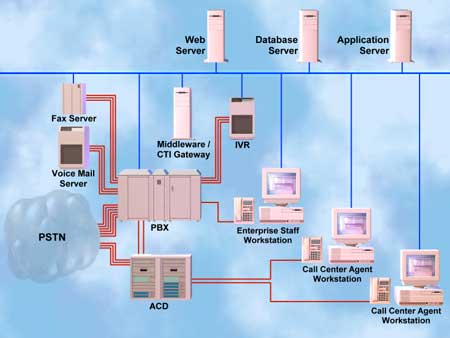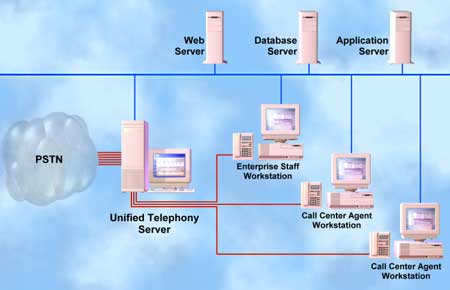|
Today's proprietary telecommunication equipment offers many appealing
features, but also presents some unwanted limitations, especially in
dealing with network convergence. With proprietary systems, customers are
forced to rely on the original vendor for changes and enhancements. Unlike
the data and PC world, third-party vendors cannot work on most
telecommunication equipment. This traditional communication architecture
often inhibits convergence because it requires two separate networks, one
for voice and another for data. In an office scenario, this requires
running two sets of wires to each desktop, one for the telephone and the
other for the PC. It also requires that system administrators install and
manage two separate networks and user databases.
In addition, most of the legacy enterprise communication environments
currently include peripheral systems such as voice mail servers, fax
servers, and voice response units integrated with the PBX. This requires
multiple boxes often provided by multiple vendors. The result of separate
PBXs, ACDs, IVRs, and voice mail systems integrated together is the chance
for multiplied performance, administrative, and support headaches.
As the telecommunications industry continues to undergo unprecedented
growth and evolution, expectations are that in the next few years, the
existing communication infrastructure of closed, proprietary hardware and
software solutions will be replaced with open, standards-based solutions.
Adopting open standards will allow greater interoperability, drives costs
down, and provides a robust development environment for third-party
software developers. In many important ways, the movement towards open
technology also streamlines the administration and management of voice, IP,
and wireless network convergence.
Separate Voice And Data
Network Architectures

Diagram courtesy of Interactive
Intelligence
The development and adoption of open, standards-based systems could do
for converging networks and the telecommunications infrastructure market
what it did for the computer market. In the computer data world, open
technology resulted in increased speed and power for processors,
dramatically lower system prices, and greater interoperability. Software
packages and reseller channels developed by tens of thousands. With open
systems, customers are not locked into one vendor, nor do they struggle
with the integration issues associated with deploying multi-application,
multi-vendor solutions.
Today's open communication systems provide a completely flexible,
single box solution for multiple networks and applications such as voice
mail, auto attendant, IVR, and even advanced functions such as IP-based
communications. Communications servers based on open hardware enable customers to
choose best-of-breed third-party software applications to perform
virtually any voice, data, or Internet communication functions.
Rather than installing and operating separate networks, open systems
enable voice and data traffic to share the same network. Not only do open
systems help facilitate functional convergence, but customers are freed
from exclusive ties to their initial vendor for upgrades or expansion.
Plus, open systems enable companies to take immediate advantage of voice
and data integration trends.
Open Communications
Server Network Architecture

Diagram courtesy of Interactive
Intelligence
MARKET DRIVERS
We can list at least six major factors that are driving open telecommunications.
Convergence: The PC quickly became the first convergent point for
computers and communications equipment. Since the PC is also the primary
platform for day-to-day data management, the convergence of information
and communications is now more prevalent than ever. As the Internet
movement further accelerates the convergence of voice, data, and video,
including videoconferencing, Internet telephony and
multimedia development over the Web is growing at exponential rates.
Lower System Costs: In most cases, the initial investment to
deploy an open telecommunication system is comparable to that of a
traditional PBX or ACD, but long-term savings for open systems can be
significant. Since traditional ACDs and PBXs have long product life
cycles, buyers cannot readily take advantage of advances in technology and
are not able to benefit from future price/performance improvements.
However, since open systems come equipped with much more functionality and
flexibility for expansion, they provide more capability per dollar. This
declining price curve, coupled with rising competition, should drive the
cost of ownership of open telecommunications systems far
below traditional systems.
Toll Bypass On VoIP Networks: Open systems can be used to
establish voice over IP gateway networks through the Internet or corporate
intranets to reduce or eliminate toll charges for long distance calls. By
using open, standards-based voice over IP gateways, companies with branch
offices or international operations can save significantly by maximizing
bandwidth usage over existing leased data lines.
Reduced Administration With Converged Networks: With open
systems, administrative costs are reduced because of greater flexibility
and easier interoperability with other equipment and software. With
traditional PBXs, something as simple as moving a phone or adding/removing
a line can require the vendor to send someone on site. Open systems can
also merge voice and data onto a single network, unlike traditional PBXs
that require separate voice and data networks.
New Market Opportunity: Open telecommunications represents a
large untapped market that offers significant growth potential for data
and computer technology companies that have traditionally been outside the
telecommunications industries. Tech giants such as 3Com, Cisco Systems,
Hewlett-Packard, Microsoft, and Intel have their sights set on the
telecommunications opportunity and intend to use their commodity computing
models to expand rapidly into this market segment. Most analysts believe
that these major data vendors will drive the adoption of open
telecommunications standards at the expense of traditional proprietary
telecommunications equipment vendors. Smaller computer telephony companies
that have long embraced the open, standards-based solutions concept are in
full support of the data vendors entering the telecommunications
marketplace, and in many instances are forming beneficial strategic
relationships with them.
Improved Bandwidth Utilization From Converged Networks: Voice
calls over the Public Switched Telephone Network (PSTN) are allocated 64
Kbps of bandwidth. Approximately 50 percent of all conversations
contain significant intervals of silence both in the gaps between words
and the time between one person talking and another responding. This
results in a large waste of the allocated bandwidth. In addition, each
conversation is allocated a dedicated circuit for the entire length of the
call. With the growing popularity of the Internet, people are dialing up and remaining logged on for prolonged periods of
time -- even when they're not actively using their connection -- thereby
making circuits unavailable for
other calls. With IP-PBXs, voice travels over the existing data network
using the excess bandwidth that is paid for but not used. For those
systems that offer gateway capabilities, voice calls can be extended to
external locations by transporting them over the Internet or over a managed IP network.
TYPES OF OPEN SYSTEMS
Open communications systems can provide network integration by including
multi-purpose functionality within the same open switching platform.
PC-PBX: Provides call control and processing functionality within
a standard PC chassis. In its most basic form, the traditional proprietary
PBX box is replaced with a PC chassis delivering PBX functions running on
a standard operating system such as Windows NT or Unix. Desktop phones are generic
analog 2500 station sets connected via traditional Category 1 or 3
telephony wiring. Besides the wiring for the phone, there is a separate
wire for the desktop PC.
IP-PBX: Any IP telephony-based device that can be connected to
a LAN or intranet that provides basic PBX functionality. All IP-PBXs use
IP as the protocol to deliver voice, but they may or may not deliver the
voice to the desktop over the network via IP phones.
PC-ACD: Provides automatic call distribution and management
reporting capabilities within a PC server by using standard operating
system software and third-party or proprietary DSP resource boards. Like
the PC-PBX, the PC-ACD replaces a traditional proprietary "box"
while the associated infrastructure remains unchanged, thus making its
operation transparent to the call center agent. These open systems
continue to work with existing equipment such as telephones, IVR units,
predictive dialers, and CTI middleware.
IP-ACD: Similar to the PC-ACD, IP-ACDs are built on standard
PC servers and open software environments. However, rather than utilizing
the PSTN, voice traffic is delivered over an IP network. This allows the
call center to operate in a multimedia environment with Web-based callers,
but also presents the challenges associated with VoIP. Desktop
communications are conducted with either a multimedia PC or a proprietary
Ethernet phone. Like the distributed IP-PBX, if the network fails, voice
communications will be lost. Unlike the PC-ACD, IP-ACDs are not limited to
just voice interactions. Because of the IP transport call center, agents
can conduct voice, e-mail, video, and text chat customer interactions.
MARKET OPPORTUNITIES
Open telecommunications solutions are particularly attractive for
managing network convergence for two market segments: enterprises and
alternative or ISP Centrex applications. In both markets, customers are
faced with expensive, difficult-to-manage telecommunication alternatives
that do little to help integrate voice and data management.
Open systems not only help streamline convergence into one network, but
they give customers greater flexibility for upgrades and system expansion
whenever needed. The net result is lower initial installation costs,
better use of bandwidth, decreased administrative costs, and the
elimination of multiple vendors.
Jonathan Shapiro is chief executive officer of Alliance
Systems. Since founding Alliance Systems in 1992, Shapiro and his
company have focused solely on standards-based, open systems for voice,
data and other telephony uses. Alliance Systems open switching platforms
run more open communications applications from more software vendors
installed in more locations by more Value Added Resellers than any other
company. As a result of its years of open systems leadership, Alliance
Systems is one of the pivotal companies building the open infrastructure
that enables converged networks and services in this new era of
communications.
|

